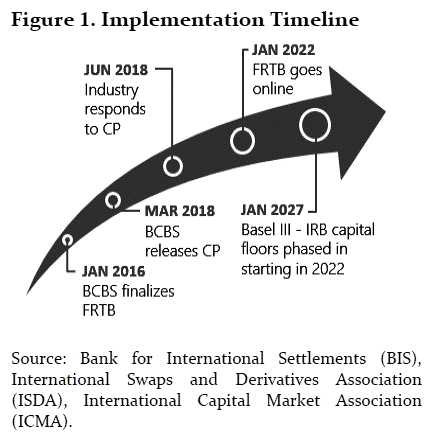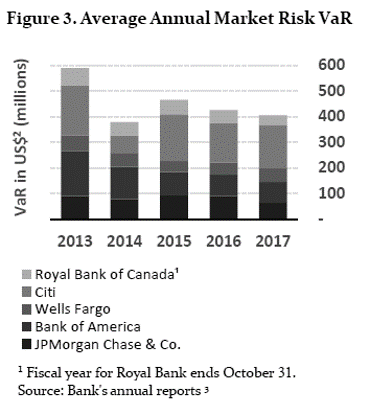Carbon Accounting Management Platform Benchmark…

Sia Partners addresses operational challenges in implementing FRTB by leveraging compliance expertise and data optimization to tackle non-modellable risk factors and ensure quality market data for meeting minimum capital requirements.
Harnessing data is a critical element in complying with the Basel Committee on Banking Supervision’s revisions to the minimum capital requirements for market risk and namely - the Fundamental Review of the Trading Book (FRTB).
Among the many ambiguities of implementing the new regulation, internal modelling of market risk exposure is emerging to be a concern. Non-modellable risk factors constitute 36% of the capital charges, among causing poor capital alignment with underlying risks, and undermining the viability of desk level internal models. With markets that have little transparency, sourcing quality market data will play a pivotal role in the difficulty of non-modellable risk.
Sia Partners is addressing this concern by leveraging its expertise in compliance and data optimization to provide an understanding of the operational challenges associated with the FRTB implementation.
The Great Recession highlighted many financial, economic, and regulatory vulnerabilities worldwide. In response to address the profound market risk exposures experienced by financial institutions, the Basel Committee on Banking Supervision (BCBS) released a new framework in January 2016 – the Fundamental Review of the Trading Book (FRTB). FRTB imposed rigorous capital requirements, defined a firm boundary between the banking book and trading book, and implemented an alternative method of measuring market risk (using Expected Shortfall [ES] as the main exposure measure in lieu of Value-at-Risk (VaR), and ensuring desk approvals for internal models with the expectation of sourcing quality market data. Loosely defined, FRTB is the next generation of market risk regulatory capital rules for large, international financial institutions.
The FRTB builds on Basel II.5’s theme of providing more attention to managing credit risk exposure and reducing the market risk framework’s cyclicality by setting higher capital requirements. On March 22, 2018, the BCBS penned a consultation paper (CP) outlining revisions to the minimum capital requirements for market risk, and an implementation and reporting extension from December 2019 to January 2022 (Figure 1). Aware of the impending developments, the “Industry” – represented by the Internal Swaps and Derivatives Association (ISDA), the Global Financial Markets Association (GFMA), and the Institute of International Finance (IIF) – provided feedback on the CP, on June 20, 2018. In their response, they emphasized the vulnerabilities to the proposed risk exposure modelling and how it would impede on market-making activities and the operational fluidity of the global capital markets. As a consequence, potentially harmful impacts could result in an emergence of rising trading costs when executing transactions, longer durations for counterparties pairing, and ultimately, a reduction in overall market liquidity.

Banks remain unclear on various aspects of the FRTB, particularly around how requirements are to be interpreted across jurisdictions and best practices to desk level implementation. Although regulation goes online in 2022, the widely used measure for market risk continues to be VaR to be replaced by ES – in order to better reflect “tail risk" (addressing large deviations away from average values) and capital adequacy.
ES is preferred over VaR because of VaR’s inability to increase as portfolios are diversified. The top 5 North American banks (by market capitalization) are JPMorgan Chase & Co., Bank of America, Wells Fargo, Citi, and Royal Bank of Canada, and they make up a combined US$1.25 trillion. Identified from their annual reports, each measured VaR at the 99 percent confidence level for price movements over a one day holding period. In aggregate, we find they are mostly exposed to interest rate risk and credit risk on an average annual basis of 27% and 25%, respectively (Figure 2).
Overall market risk exposure has been gradually falling, with the total average annual market risk VaR across the top 5 banks being reduced by 31% from US$590 million in 2013 to US$405 million in 2017 (Figure 3). Many financial institutions still voice concern regarding stricter capital requirements in conjunction with increased compliance costs reducing profits.

These stricter requirements essentially place a higher burden on accurate and effective risk modelling despite ongoing challenges to the procurement of quality data sets, especially regarding illiquid assets and non-modellable risk factors (NMRFs.).

A bank must acquire desk approvals for dealing with risk exposures, namely: for both credit spread and default risk. For the ones that fall short of this hurdle, the desk will be deemed ineligible for internal modelling. The Internal Model Approach (IMA) is the best-case scenario for a firm for having lower capital charges. To illustrate the benefit on the IMA versus the SA, the Industry conducted an impact study using a sample of 33 banks with quality data. The findings demonstrated FRTB capital for trading desks under the IMA is 3.21 times larger than the capital based on current IMA rules. To have trading desks govern the process, they are first required to be: (1) nominated by the bank and, (2) satisfy back-testing, P&L attribution tests, and capitalization levels. A rigorous process of stress testing is essential to standardize ES by applying a dataset with a sample size of 10 years (at minimum). Depending on the class of risk factor, market liquidity is integrated into the application by certifying a liquidity horizon range between 10-250 days. Under this approach, although preferably ideal, securing market data on assets with varying liquidities is a challenge to ensuring regulatory model approvals.
The Standardized Approach is the easier fallback method for determining capital charges if the bank fails on implementing a sufficient internal model. The SA capital requirement stems from the summation of three components; (1) risk charges under the sensitivities-based method, (2) the default risk charge, and (3) the residual risk add-on. Under this method, the financial institution must provide a regular disclosure report, for all trading desks.
The FRTB requires banks to source reliable data to comply with standards. For banks that wish to use the IMA, they must pass the NMRF test which places a strain to source data and organize and map these risk factors. A June 2017 report by the ISDA, GFMA, and IIF highlighted that 36% of the IMA capital charge will be attributed to NMRFs. When adopting the IMA, there is immense value in measuring capital charges by favorable risk weightings. If left unattended, the consequence are cliff effects between the SA and IMA - mainly due to banks losing approvals as a cause of insufficient market data and robust testing. Many firms are still in the early stages of developing and executing a forward thinking FRTB strategy and are looking for ways to address the key challenges while supporting the business.
Non-modellable risk factors (NMRFs) could result in overcapitalization, poor capital alignment with the underlying risks, and will undermine the viability of the IMA. Classified as a capital add-on under the ES model, the BCBS addresses the dilemma of risk modelling for instruments lacking sufficient price observations. For a risk factor to be considered as “modellable”, the BCBS states that there must be “continuously” available “real” prices for a representative set of transactions. The criteria to establish whether a price is “real” it must be a price that is: (1) an institutional conducted transaction or (2) a transaction between other arm’s-length parties or (3) obtained from a committed quote.
To be considered “continuously” available “real” prices, the risk factor must satisfy two rules. First, the minimum price observation rule – where 24 price observations per year measured over the period to calculate ES must be obtained. Second, the one-month gap rule – a maximum period of one month must be between two consecutive price observations. The criteria is required to be assessed on a monthly frequency. The inability to model poses a critical threat to banks as most of their market risk exposure stems from risks with limited available data due to their illiquidity. NMRFs remain as the key contributor to the IMA capital charge. The ISDA, GFMA, and IIF conducted an analysis using approximately 20,000 risk factors that have a minimum of one price observation per period. They discovered that 71% of them are non-modellable (Figure 4).
Seasonality, new issuances, and associations to exotic instruments also contribute towards the inability of banks to obtain “real” prices using their personal transaction data. Timing of when trading activities occur have an impact on the eligibility of risk factors. For example, liquid products that are traded at the beginning and end of every month would fail the one-month requirement.

A June 2018 study conducted by Morgan Stanley looked at a representative sample of U.S corporate bonds and discovered in their findings that only 43% of the assets meet the one-month gap rule. By extending the allowable time-gap between months to 90 days, they found that 60% of the same representative sample would satisfy a 3-in-90 day test. Implying that trading activities of liquid products could follow cyclical patterns - resulting in failing the one-month gap rule. Understanding NMRFs is still a process that is evolving as developments between the regulator and the industry continue to grow. The anticipation is that a large amount of risk factors are to be non-modellable. The ISDA and the Association for Financial Markets in Europe (AFME) identified the most relevant and common risk factors as:
Improving a firm’s FRTB pricing observations strategy is an important concern for firms implementing the new regulation.
Sia Partners is a leader in market data contract compliance, operations, technology, and advisory services.
Sia Partners has extensive experience guiding organizations navigate through optimization programs and associated organizational transformations. We have supported a significant number of buy- and sell-side firms through the development of models and implementation of road maps. Our unique range of experience and skills has positioned us to effectively diagnose, design, and implement change successfully. MDC’s Framework helps investment firms ensure that commitments to compliance and data optimization are clearly articulated and aligned to other strategic objectives.